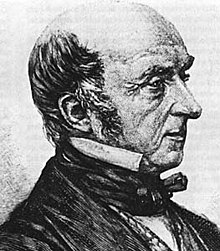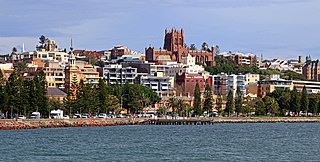
Newcastle or Greater Newcastle, locally nicknamed Newy, is a regional metropolitan area and the second-most-populated district in New South Wales, Australia. It includes the cities of Newcastle and Lake Macquarie; it is the hub of the Lower Hunter region, which includes most parts of the local government areas of City of Newcastle, City of Lake Macquarie, City of Maitland, City of Cessnock, and Port Stephens Council.

Port Stephens, an open youthful tide-dominated drowned-valley estuary, is a large natural harbour of approximately 134 square kilometres (52 sq mi) located in the Hunter and Mid North Coast regions of New South Wales, Australia.

The Australian Agricultural Company (AACo) is a public-listed Australian company that, as of 2018, owns and operates feedlots and farms covering around seven million hectares of land in Queensland and the Northern Territory, roughly one percent of Australia's land mass. As of July 2008 AACo had a staff of 500 and operated 24 cattle stations and two feedlots, consisting of over 565,000 beef cattle.
Nelson Bay is a significant township of the Port Stephens local government area in the Hunter Region of New South Wales, Australia. It is located on a bay of the same name on the southern shore of Port Stephens about 60 kilometres (37 mi) by road north-east of Newcastle, its nearest rail link. At the 2021 census, Nelson Bay had a population of 6,141.

Great Lakes Council was a local government area in the Mid North Coast region of New South Wales, Australia. The area is situated adjacent to the shores of Port Stephens, Myall Lakes and Wallis Lake and the Pacific Highway and the Lakes Way. On 12 May 2016 the council was dissolved and the area included in the Mid-Coast Council, along with the City of Greater Taree and Gloucester Shire.

Woodville is a rural suburb in the Hunter Region of New South Wales, Australia that is shared between the Port Stephens and Maitland local government areas (LGA). Most of the suburb lies to the east of the Paterson River in the Port Stephens LGA while a small area of approximately 1.3 square kilometres (0.5 sq mi), to the west of the Paterson, is within the boundaries of the Maitland LGA.

Karuah is a locality in both the Port Stephens and Mid-Coast Councils, the Port Stephens lga side is part the Hunter Region while the Mid-Coast lga is in the Mid North Coast region of New South Wales, Australia. It is thought that the name means 'native plum tree' in the local Aboriginal dialect.

Dungog Shire is a local government area in the Hunter region of New South Wales, Australia. The Shire is situated adjacent to the Barrington Tops and consists predominantly of very rugged to hilly country which becomes less rugged from north to south.
The Worimi people are Aboriginal Australians from the eastern Port Stephens and Great Lakes regions of coastal New South Wales, Australia. Before contact with settlers, their people extended from Port Stephens in the south to Forster/Tuncurry in the north and as far west as Gloucester.
North Arm Cove is a suburb of the Mid-Coast Council local government area in the center of the Hunter and the southern extremity of the Mid North Coast regions of New South Wales, Australia. It is located adjacent to Port Stephens and extends well north of the Pacific Highway. The suburb is sparsely populated, with most of the residents living in the southern portion of the suburb.

Tanilba Bay is a suburb of the Port Stephens local government area in the Hunter Region of New South Wales, Australia. It is located on the Tilligerry Peninsula adjacent to the bay from which it got its name. "Tanilba" is said to mean "place of white flowers" in a local Indigenous language, presumably a reference to the flannel flowers which formerly thrived in the area. At the 2021 census Tanilba Bay had a population of 3,237. Tanilba Bay Public School is a co-ed government primary school located at 1A King Albert Avenue.
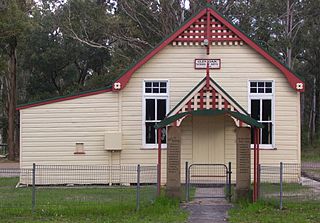
Glen Oak is a small community in the Hunter Region of New South Wales, Australia, shared between the Port Stephens and Dungog local government areas (LGA). Approximately two thirds of the suburb's 45.1 square kilometres (17.4 sq mi) is located within the Port Stephens LGA while the remaining third, which is sparsely populated, is located in Dungog Shire.
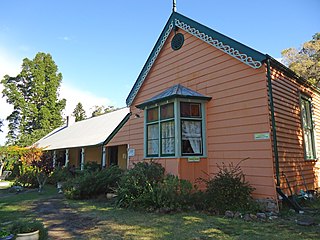
Tahlee is a heritage-listed former pastoral property of 68.8 hectares in the suburb of Tahlee situated on the north side of Port Stephens near Karuah in New South Wales, Australia. It is the original site of the Australian Agricultural Company and more recently the location of the former Tahlee Bible College. It was added to the New South Wales State Heritage Register on 2 April 1999.
Tahlee Bible College (TBC) functioned for nearly 70 years as an interdenominational training centre situated at Tahlee, a 170-acre (0.69 km2) property on the shores of Port Stephens, Australia, less than one hour north of Newcastle and less than three hours north of Sydney.

Robert Hoddle Driberg White was an Australian politician. He was the member for the New South Wales electorate of Gloucester from December 1882 to January 1887 and a member of the Legislative Council from December 1887 until his death in 1900. White was known for his extravagant lifestyle and lavish hospitality at his 'Tahlee' estate at Port Stephens.
Carrington is a locality in the Mid-Coast Council local government area of the Hunter and Mid North Coast regions of New South Wales, Australia, located on the northern shores of Port Stephens.

Stroud House is a heritage-listed residence at 42 Cowper Street, Stroud, Mid-Coast Council, New South Wales, Australia. It was built from 1827 to 1839. It was added to the New South Wales State Heritage Register on 4 March 2016.

Avery Terrace is a row of heritage-listed terrace houses located at 2–4 Atherden Street in the inner city Sydney suburb of The Rocks in the City of Sydney local government area of New South Wales, Australia. It was designed in 1881, and it is also known as Former Ebsworth's Terraces and Ebsworth's. The property is owned by Property NSW, an agency of the Government of New South Wales. It was added to the New South Wales State Heritage Register on 10 May 2002.
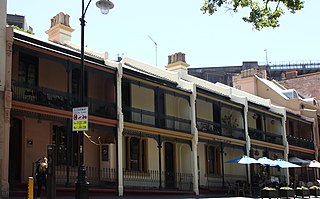
The Sergeant Major's Row are heritage-listed former terrace houses and now shops and offices. They are located in a row at 33–41 George Street in the inner city Sydney suburb of The Rocks in the City of Sydney local government area of New South Wales, Australia. The row was built in 1881. It is also known as Sergeant Majors Row (terrace) and Major's. The property is owned by Property NSW, an agency of the Government of New South Wales. It was added to the New South Wales State Heritage Register on 10 May 2002.

Robert Dawson (1782–1866) was a company agent and pastoralist in New South Wales in the early part of the nineteenth century. He was born in Essex, England and was the youngest son of Joseph Dawson. Dawson was working in England as the estate manager for Viscount Barrington's estate, Becket, when he was approached by John Macarthur junior, and old school friend, to apply for the post of chief agent in New South Wales for the newly formed Australian Agricultural Co. in which he was to establish and administer a pastoral grant of 1,000,000 acres (404,686 ha) subject to a committee resident there. The AA co. appointed Robert Dawson as their chief agent and appointed a Colonial Committee to assist him. This committee was entrusted by the directors in England with 'extensive discretionary powers'. Dawson was advised to accept their advice at all times. However the committee effectively included just three people, all members of the same family - James Macarthur, his cousin Hannibal Macarthur and his brother-in-law, Principal Surgeon, James Bowman. Dawson had several disagreements with the colonial committee as soon he arrived in Australia in 1825 and as such was maligned by the committee. Dawson received very little help from the committee and as such did most if the work managing the AA Co. affairs himself. The committee members and their acquaintances sold Dawson questionable sheep with foot rot and other diseases as well as older ewes that could not raise lambs. Dawson eventually refused to buy any more stock from the committee and so they set about to have him dismissed. The committee were successful in having Dawson dismissed but they were also dismissed and their reputations damaged. Dawson returned to NSW in 1839 with his second wife to superintend his estate and was appointed as magistrate for the area.



